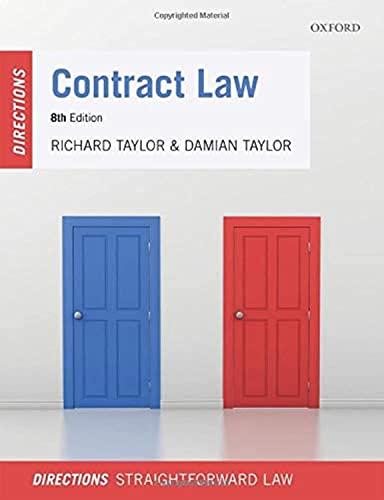Question
1. Describe the four different types of property ownership 2. define and give an example of an easement and 3. define and describe adverse possession.
1. Describe the four different types of property ownership 2. define and give an example of an easement and 3. define and describe adverse possession.
2. Please define trademark law. Explain the different types of trademarks and three methods of defending against a trademark lawsuit. Additionally, what is a trade secret and how is a trade secret established?
3. Describe the difference between a quasi-legislative and quasi-judicial agency and give an example of each. Additionally, explain 2 reasons why administrative agencies are necessary. Lastly, describe 2 criticisms of administrative agencies.
4. Define what a security is, who are the parties regulated under the Securities Act of 1933, describe why Congress passed the Sarbanes-Oxley Act of 2002 and describe the Act's major provisions and their impact on business.
5. Please define false advertising. Additionally, please explain what a "reasonable consumer" is, the elements of false advertising and what the FTC looks at in evaluating false advertising cases. Also what is the purpose of the fair debt collection practices act?
6. Explain the essence of the Clean Water and Clean Air Acts. What is the difference between a primary air quality standard and secondary air quality standard? What is emissions reduction banking? Concerning the clean water act, what is the difference between a point and non-point source of pollution? Do you think these regulations are too ownerous or not ownerous enough on business?
7. Explain which businesses the Civil Rights Act of 1964 applies to, the Act's purpose, what types of discrimination are protected, the types of employer actions to which discrimination is prohibited and define bona fide occupational qualifications (BFOQs) and explain their role in the legal defense of the employer using an original example.
8. Explain the major provisions of the Family and Medical Leave Act (FMLA). Additionally please explain which business and employees the Act applies to and what remedies are available to workers who have been denied rights under the Act. Lastly, explain the purpose of the Warn Act and describe its major provisions.
9. Describe three labor law related act that predated the 1935 Wagner Act. What was the reason the Wagner Act was passed and what is the purpose of the National Labor Relations Board? Lastly, describe 3 different unfair labor practices by management.
Step by Step Solution
There are 3 Steps involved in it
Step: 1

Get Instant Access to Expert-Tailored Solutions
See step-by-step solutions with expert insights and AI powered tools for academic success
Step: 2

Step: 3

Ace Your Homework with AI
Get the answers you need in no time with our AI-driven, step-by-step assistance
Get Started


